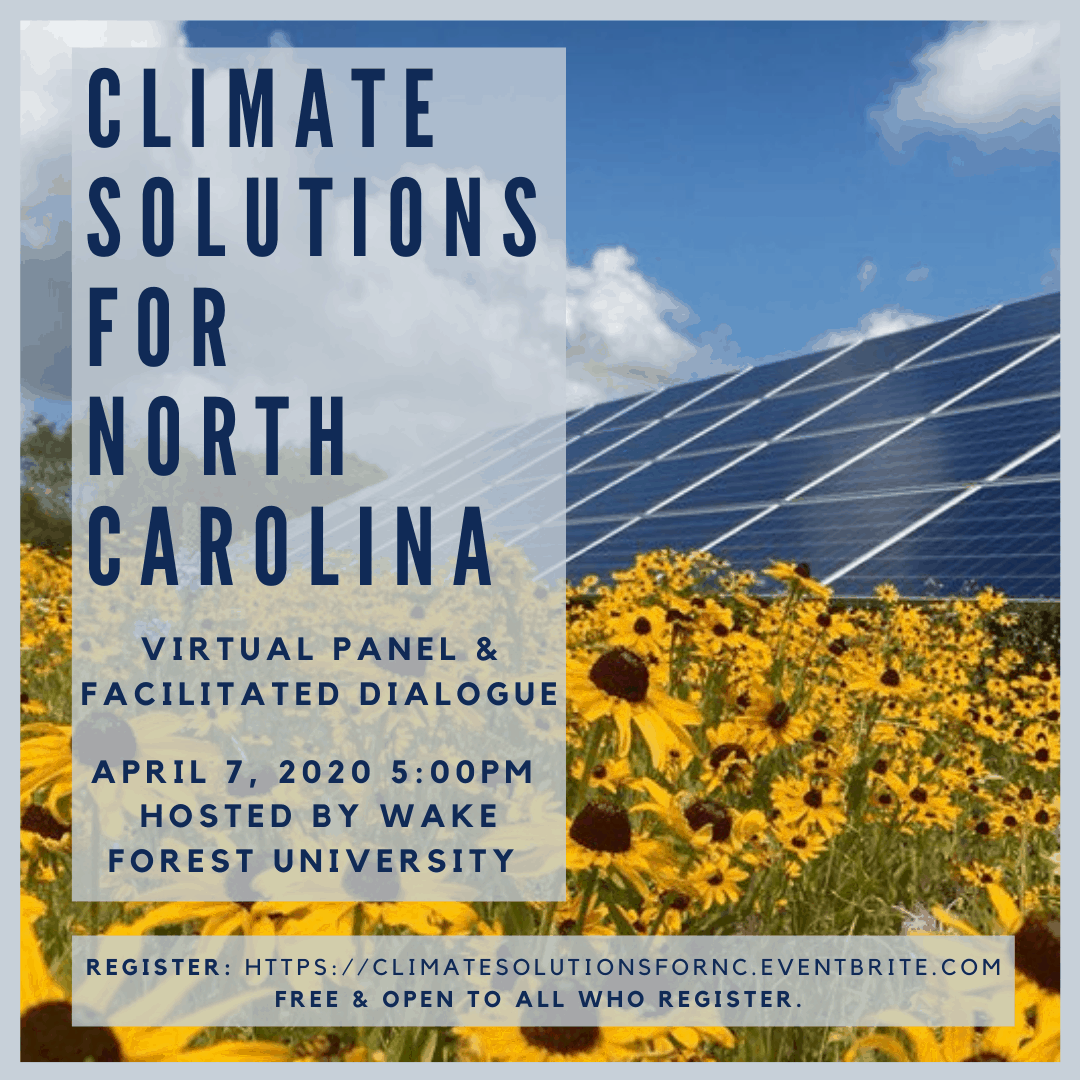Climate Solutions for North Carolina

Although in-person events planned for Wake Forest’s annual Earth Month have been cancelled, the virtual show has gone on with engaging opportunities for students, faculty, and staff to scale up solutions for climate action.
The Office of Sustainability’s virtual panel and dialogue, “Climate Solutions for North Carolina,” brought nearly 150 students, faculty and community members together from across the country on Tuesday, April 7 for presentations on climate solutions from panelists and breakout discussions on climate choices facilitated by staff colleagues from the Office of Civic and Community Engagement.
The event was part of Solve Climate by 2030 — webinars across nearly all 50 states highlighting state-level climate solutions. Wake Forest University hosted the webinar for the state of North Carolina. The webinar was framed within the context of Wake Forest’s recent progress toward climate solutions, and the recognition that the university and the state of North Carolina still has room for improvement. Wake Forest has achieved a 30% reduction in greenhouse gas emissions from a 2007 baseline. The university is projected to achieve a 50% reduction by 2030, in order to reach a goal of carbon neutrality by 2050.
Jess Whitehead, the chief resilience officer of the North Carolina Office of Recovery and Resiliency (NCORR), explained why climate change poses a significant risk and how increased resiliency can improve the ability of communities in North Carolina to respond to climate change.
During her time at NCORR, she provided assistance during Hurricane Florence and Hurricane Matthew and explained that these floods, among other problems managed by NCORR, are exacerbated by climate change, which can increase the number of extreme precipitation events, lead to warmer nights, cause sea levels to rise and result in high tide flooding. To address these issues, Whitehead explained that the focus must be shifted from assistance in the aftermath to precautionary measures, such as building resilience.
“A resilient North Carolina is a state where our communities, economies, and ecosystems are better able to rebound, positively adapt to, and thrive amid changing conditions and challenges, including disasters and climate change,” said Whitehead.
Following this discussion of community-oriented work, Elizabeth Ouzts, a journalist for the Energy News Network and the former director of communication for Environment America, examined the role that administrative decisions play in terms of climate solutions. She explained that one main obstacle hindering progress toward renewable energy in North Carolina is Duke Energy’s unwillingness to stop fossil fuel investments, as the business recently proposed the establishment of new gas units and extensions of two pipelines. Other barriers identified were the lack of political will, the monopoly electricity utility model and the transportation sector.
To solve these issues, she urged participants to demand environmental policy action at the state and national levels. She explained that the goals for which people advocate must be ambitious, since achieving 100% renewable energy would require a moratorium on new fossil fuel infrastructure investments, a 40% drop in energy use and a clean electricity grid.
Finally, Steve Kalland, the executive director of the NC Clean Energy Technology Center, spoke on the climate solution of energy policy. Kalland emphasized the importance of flattening the curve of greenhouse gas emissions, which he said can be achieved by increasing energy efficiency and then implementing more renewable energy. Like Outzts, he called for participants to act as stakeholders in energy policy.
After hearing these different approaches to mitigating climate change, participants were divided into three breakout rooms for discussions using the deliberative dialogue framework on climate choices. This process engaged participants, allowing them to share their perspectives on three outlined climate choices: 1) accelerating innovation, 2) preparing and protecting our communities, and 3) reducing GHG emissions. Trained facilitators from the Office of Civic and Community Engagement, Marianne Magjuka, Shelley Sizemore, and Deb Marke, led the breakout rooms in their discussions.
As participants bounced ideas back and forth, they conversed about the best way to approach climate change, and more importantly, how to get others to adjust their behaviors accordingly. Many groups talked about climate solutions as a matter of community and civic action with shared responsibility.
“Actions have a ripple effect,” said Christopher Zarzar, who participated in the breakout discussion. “Start and do something.”
Action items included bringing business and faith organizations together and challenging down-ballot candidates to share their stance on environmental issues. The solutions spoke to the power of collaborative action, something that many are finding especially important as communities come together during the global COVID-19 pandemic.
“I would encourage you to look for no regrets actions,” Whitehead said. “The pandemic has really exposed the vulnerabilities of our communities. Find the things that build resilience in your community, because a lot of those are things that are going to build resilience in the future.”
